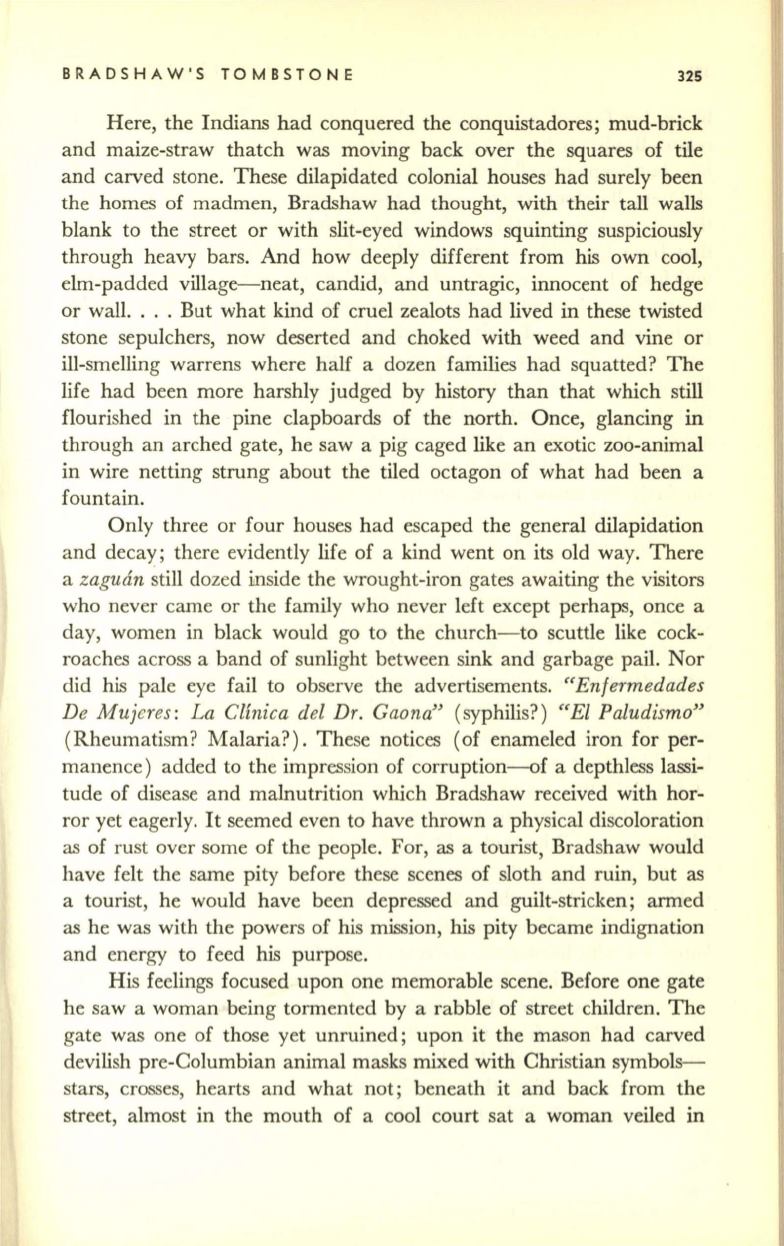
BRADSHAW'S TOMBSTONE
325
Here, the Indians had conquered the conquistadores; mud-brick
and maize-straw thatch was moving back over the squares of tile
and carved stone. These dilapidated colonial houses had surely been
the homes of madmen, Bradshaw had thought, with their tall walls
blank to the street or with slit-eyed windows squinting suspiciously
through heavy bars. And how deeply different from his own cool,
elm-padded village-neat, candid, and untragic, innocent of hedge
or wall. ... But what kind of cruel zealots had lived in these twisted
stone sepulchers, now deserted and choked with weed and vine or
ill-smelling warrens where half a dozen families had squatted? The
life had been more harshly judged by history than that which still
flourished in the pine clapboards of the north. Once, glancing
in
through an arched gate, he saw a pig caged like an exotic zoo-animal
in wire netting strung about the tiled octagon of what had been a
fountain.
Only three or four houses had escaped the general dilapidation
and decay; there evidently life of a kind went on its old way. There
a
zaguan
still dozed inside the wrought-iron gates awaiting the visitors
who never came or the family who never left except perhaps, once a
day, women in black would go to the church- to scuttle like cock–
roaches across a band of sunlight between sink and garbage pail. Nor
did
his
pale eye fail to observe the advertisements.
(fEnfermedades
De Mujeres : La Clinica del Dr. Gaona"
(syphilis?)
(fEZ Paludismo"
(Rheumatism? Malaria?). These notices (of enameled iron for per–
manence) added to the impression of corruption-of a depthless lassi–
tude of disease and malnutrition which Bradshaw received with hor–
ror yet eagerly. It seemed even to have thrown a physical discoloration
as of rust over some of the people. For, as a tourist, Bradshaw would
have felt the same pity before these scenes of sloth and ruin, but as
a tourist, he would have been depressed and guilt-stricken; armed
as he was with the powers of his mission, his pity became indignation
and energy to feed his purpose.
His feelings focused upon one memorable scene. Before one gate
he saw a woman being tormented by a rabble of street children. The
gate was one of those yet unruined; upon it the mason had carved
devilish pre-Columbian animal masks mixed with Christian symbols–
stars, crosses, hearts and what not; beneath it and back from the
street, almost in the mouth of a cool court sat a woman veiled in


